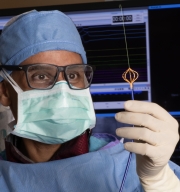Pulsed Field Ablation – A New, Safer Treatment for A-fib
Medically Reviewed by Prabal K. Guha, MD
Dr. Prabal Guha, McLeod Electrophysiologist, explains a new therapy called pulsed field ablation (PFA) being used to treat Atrial fibrillation or A-fib.
Safe and successful ablations are being performed at McLeod Regional Medical Center using a new FDA-approved therapy called pulsed field ablation (PFA).
PFA catheter therapy uses short bursts of high energy to affect heart tissue that causes Atrial fibrillation, or A-fib. This is opposed to traditional ablations that use thermal energy.
The Benefits of PFA:
- Safer procedures
- Only targets affected cells and not surrounding tissue
- Successful results
PFA relies on tissue-selective, non-thermal electric fields to ablate heart tissue, avoid damage to areas surrounding the heart and treat A-fib.
More About A-fib
Atrial fibrillation or A-fib is a type of arrhythmia or irregular heartbeat that is the most common electrical problem of the heart. More than two million Americans live with some form of it.
The heart has two upper chambers and two lower chambers whose job is to circulate the blood throughout the body. With a heart in atrial fibrillation, the upper chambers cannot contract sufficiently and are unable to push the blood to the lower chambers smoothly. Instead, it is very disorganized, making the heart look like it is quivering.
Because of the “quivering,” the heartbeats are irregular, and in some cases faster than normal. When this happens patients may feel like their heart is pounding or fluttering. Also, since the lower chambers are not getting completely filled with blood, patients can undergo feelings of fatigue, dizziness, lightheadedness, shortness of breath or lack of energy during exercise. But not everyone will experience these symptoms. Many patients aren’t even aware they have it.
The greatest problem is that atrial fibrillation increases the risk of stroke. Patients with A-fib are more likely to have a stroke compared to those without this condition. Since the upper heart chambers do not push blood well to the lower chambers it can pool in the upper chambers and form clots. These clots may dislodge, travel through the arteries to the brain and cause a stroke.
Correcting the Problem
Restoring a normal heart rhythm is important for patients who have been newly diagnosed and/or have noticeable symptoms from A-fib. Special medicines or an electrical cardioversion, an electrical shock to the heart, can restore heart rhythm. If these methods fail, then an ablation can be performed.
An ablation is a catheter procedure to reroute the heart’s electrical activity in the upper chambers by destroying small areas in the heart involved in the abnormal rhythm. This prevents any abnormal electrical signals from moving through the heart.
Traditional ablations use hot or cold energy to burn or freeze the tissue causing the problems in the heart.
The new PFA therapy uses short, high-amplitude electrical pulses to kill the heart tissue causing A-fib. PFA can target just the myocardium, the muscle layer of the heart that’s responsible for irregular electrical signal, reducing the risk of damage to nerves and other tissue.
Visit a McLeod cardiologist near you and learn more.
-
McLEOD REGIONAL MEDICAL CENTER FLORENCE
843-777-2000 -
McLEOD DARLINGTON
843-777-1100 -
McLEOD DILLON
843-774-4111 -
McLEOD LORIS
843-716-7000 -
McLEOD SEACOAST
843-390-8100 -
McLEOD CHERAW
843-537-7881 -
McLEOD CLARENDON
803-433-3000



-
McLEOD REGIONAL MEDICAL CENTER FLORENCE
843-777-2000 -
McLEOD DARLINGTON
843-777-1100 -
McLEOD DILLON
843-774-4111 -
McLEOD LORIS
843-716-7000 -
McLEOD SEACOAST
843-390-8100 -
McLEOD CHERAW
843-537-7881 -
McLEOD CLARENDON
803-433-3000
 Find a Doctor
Find a Doctor  Locations
Locations  Services
Services 